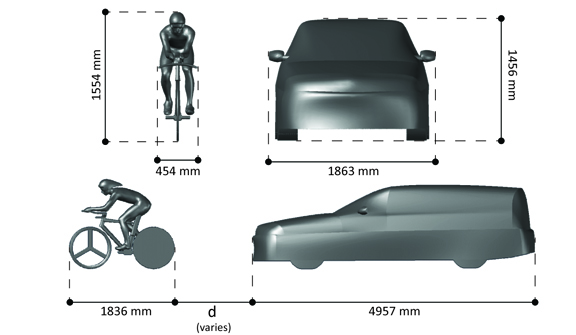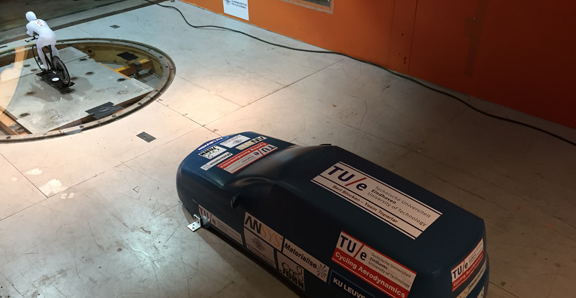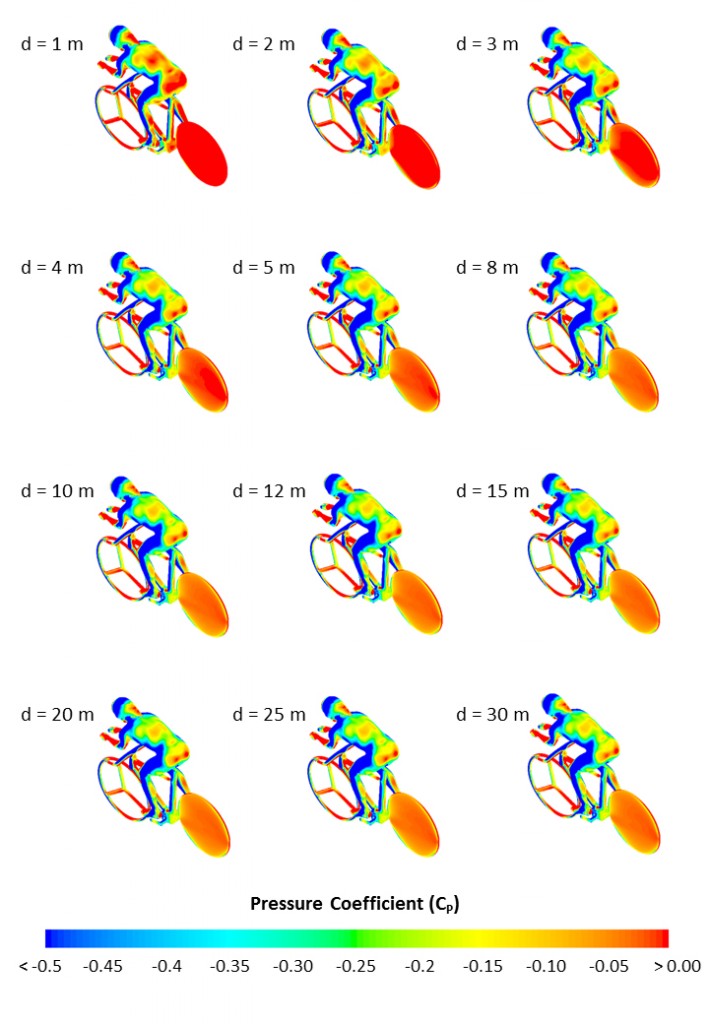
The 3D model of a cyclist was based on a scan of a cycling champion. The vehicle model was purchased online.
June 29, 2015
 The setup at Eindhoven University of Technology to understand the effects of a car following a cyclist.
The setup at Eindhoven University of Technology to understand the effects of a car following a cyclist. The 3D model of the cyclist was based on a scan of a cycling champion. The vehicle model was purchased online.
The 3D model of the cyclist was based on a scan of a cycling champion. The vehicle model was purchased online.Professor Bert Blocken, PhD student Yasin Toparlar, and Thierry Marchal may have uncovered something that could affect the outcome of the Tour de France (July 4-26). The real race will take place roughly a week from now, along the 3,360-kilometer route that stretches from Utrecht to Sèvres, but Marchal pointed out, “Part of the race can be won in front of the computer.”
Blocken, the chair of Building and Urban Physics at the Eindhoven University of Technology in the Netherlands and at Leuven University in Belgium, and Marchal, engineering simulation software maker ANSYS‘s global industry director for healthcare, consumer product, and construction, have spent a good part of their careers recreating physical phenomenons—like the aerodynamics of moving cars and trains—in pixels inside computers. At first glance, their professional expertise seems to have nothing in common with the cycling champions who rely on their muscles, training, and stamina. But it does.
“We have begun working with athletes going for the Olympic Gold,” said Marchal. The same ANSYS technology used to simulate and study the airflow around a passenger jet or a Formula One racecar can be applied to a swimmer or a cyclist.
“In a cycling race, the frontrunner is protecting the follower from the wind effect, so it’s generally understood it’s easier to be behind someone,” explained Marchal. “But Bert Blocken and his team found out the follower may also be influencing the frontrunner’s performance by pushing the air toward the front.”
In the case of a vehicle following a cyclist, Blocken and his PhD student Yasin Toparlar discovered that the effect is significant enough to change the outcome of the race. Thierry Marchal convinced them to communicate these results to the International Cycling Union and to the international press.
The Race Inside the Computer
Currently, a car following a cyclist in the race is required to keep a distance of 10 m for safety reasons. But based on the research from Eindhoven University of Technology with the ANSYS software, this distance should be reexamined.
“We were simply trying to understand the physics of the influence of a car following a cyclist on the drag of this cyclist,” explained Blocken. “We first did a computational fluid dynamics (CFD) simulation in ANSYS software. We then confirmed our numbers with a wind tunnel test.”
The 3D geometry of the cyclist came from a laser scan from a previous project dating back to 2006. The 3D model of the vehicle was purchased online, from one of the 3D content suppliers. The simulated scenario covers a 50-kilometer distance. The researchers incrementally reduced the distance between the car and the cyclist to see what happened.
“When the car was following the cyclist at a five-meter distance, the drag reduction gave the cyclist an advantage of about 24 seconds over the car following at 30 meters,” explained Blocken. “Conducting CFD simulations allowed us to put the cyclist and the car extremely close to each other. You wouldn’t be able to do that in a real experiment because it would be dangerous to the cyclist.”
 Software simulation allows researchers to repeat the same scenario by varying the distance between the cyclist and the car.
Software simulation allows researchers to repeat the same scenario by varying the distance between the cyclist and the car.CFD As a Predictive Tool
CFD should be used where it counts most, Marchal suggested. “For certain segment of the race, like the stages involving mountain climbing, you might not want to do CFD for the climb, where everyone slows down. But for downhill, it makes more sense,” he explained.
Some sports equipment manufacturers now work with CFD experts to improve product performance. For example, bike makers and helmet makers could reshape their products to improve airflow and reduce drag. Even the cycling and swimming suits are subject to scrutiny under CFD for possible aerodynamic improvement. (For more, read “CFD Making Waves in Olympic Swimwear Again,” August 2012.)
Blocken and his colleague Professor Peter Hespel at Leuven University started working with the Flemish Cycling Union in 2006, to use digital simulation to understand how the posture, height, and shape of the cyclist affect the outcome of the race. The secret to success, Blocken observed, was in balancing aerodynamics and power.
“If you’re in an aerodynamically optimal position on the bike, you don’t generate the maximum power,” he explained. “And if you’re generating the maximum amount of power, you won’t be very aerodynamic.” Therefore, at least in theory, every cyclist can find a pose that works best for himself or herself in a race by seeking the optimal aerodynamic-power balance.
But if would be a mistake to think of CFD as the ultimate predictor of competitive sports. “We can boost the athlete’s performance with equipment, optimize his or her situation, but the athlete is the one who must deal with tiredness, keep up morale, and pedal the bike,” Marchal pointed out.
Blocken anticipates skepticism on his research from some, but he’s confident in his findings. He said, “The agreement between the digital simulation and the real wind tunnel test was even better than expected. And we have 17 years of experience in performing accurate and reliable CFD simulations with the ANSYS software.”
To Keep the Game Fair
Eindhoven University of Technology and ANSYS plan to formally notify the cycling community and the regulatory organizations with their findings.
“We feel we need to go public with the findings because we are concerned with the fairness of the game,” said Marchal. “We also want the UCI to be aware of that so it could modify the regulations.”
It’s yet unclear what type of changes the UCI or the Tour de France authorities might implement in response.
Subscribe to our FREE magazine, FREE email newsletters or both!
About the Author
Kenneth Wong is Digital Engineering’s resident blogger and senior editor. Email him at [email protected] or share your thoughts on this article at digitaleng.news/facebook.
Follow DE





